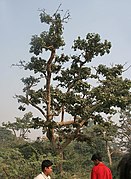Mitragyna parvifolia
| Mitragyna parvifolia | |
|---|---|

| |
| Flower seen in Bengaluru | |
| Scientific classification | |
| Kingdom: | |
| (unranked): | |
| (unranked): | |
| (unranked): | |
| Order: | |
| Family: | |
| Subfamily: | |
| Tribe: | |
| Genus: | |
| Species: | M. parvifolia
|
| Binomial name | |
| Mitragyna parvifolia | |
| Synonyms | |
|
Nauclea parvifolia Roxb. | |
Mitragyna parvifolia is a tree species found in Asia.[2][3] It is native to India. Mitragyna species are used medicinally as well as for their fine timber throughout the areas they grow. It reaches heights of 50 feet with a branch spread of over 15 feet. The stem is erect and branching. Flowers are yellow and grow in ball-shaped clusters. Leaves are a dark green in color, smooth, rounded in shape, and opposite in growth pattern.[4]
Traditional Uses
Mitragyna parvifolia fresh leaves sap is used by the tribals in treatment of jaundice in the Chenchus, Yerukalas, Yanadis and Sugalis of Gundur District, Andhra Pradesh. Its leaves alleviate pain, swelling and for better healing from wounds and ulcers. M. parvifolia stem bark is used in treatment of biliousness and muscular pains by the local inhabitant of Tumkur district, Karnataka, India. The tribals of Sonaghati of Sonbhadra district, Uttar Pradesh to heal fever by decoction of the M. parvifolia bark. Valaiyans tribe, population of Sirumalai hills, Madurai district, Western Ghats, Tamil Nadu utilize stem bark of M. parvifolia for rheumatic pain. The bark and roots used to treat fever, colic, muscular pain, burning sensation, poisoning, gynecological disorders, cough, edema and as an aphrodisiac. The fruit juice augments the quantities of breast milk in lactating mothers and also work as lactodepurant.[5]
The caterpillars of the commander (Limenitis procris), a brush-footed butterfly, utilize this species as a food plant.[6]
Gallery
-
Trunk at Hodal in Faridabad district of Haryana, India
-
Old tree at Hodal in Faridabad district of Haryana, India
-
Young tree at Hodal in Faridabad district of Haryana, India
References
- ^ "Mitragyna parvifolia (Roxb.) Korth". The Plant List. Retrieved 17 July 2013.
- ^ "Taxon: Mitragyna parvifolia (Roxb.) Korth". Germplasm Resources Information Network (GRIN). United States Department of Agriculture, Agricultural Research Service, Beltsville Area. Retrieved 17 July 2013.
- ^ Sharad Singh Negi, Shgarad Singh (2000). Himalayan Forests and Forestry. Indus Publishing. p. 139. ISBN 978-81-7387-112-2. Retrieved 18 July 2013.
- ^ "Mitragyna parvifolia - Kaim". www.flowersofindia.net. Retrieved 2016-11-03.
- ^ "A Review on Mitragyna parvifolia (Roxb.) Korth. - An Indian Medicinal Plant". International Journal of Pharmacy and Pharmaceutical Research. 7.
- ^ Kunte, Krushnamegh (2000). Butterflies of Peninsular India. India, A Lifescape. Hyderabad, India: Universities Press. p. 224. ISBN 978-8173713545.
External links












